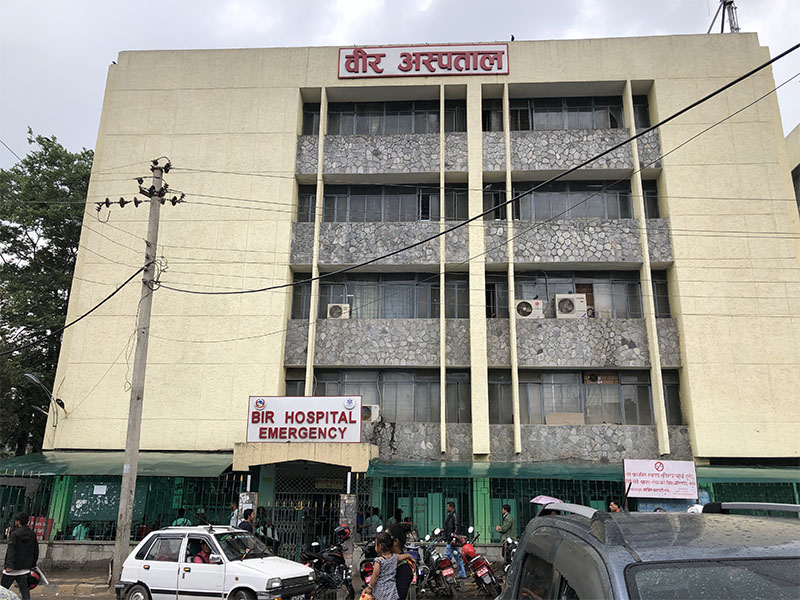CT scan service shut following radiation leak
Kathmandu, June 22
Bir Hospital shut down its CT scan service yesterday after radiation was found leaking from its highly shielded room.
The hospital has closed its services upon the recommendation of Nepal Academy of Science and Technology as a monitoring team from NAST found higher level of radiation in areas around the CT scan room. It has suggested that the hospital adopt protection measures against radiation leakage. The hospital had fixed a new CT scan machine six months ago.
Immediate exposure to high level of radiation will harm blood and skin cells. Effect of radiation on gonads, one of the reproductive organs in a male or female can lead to birth defects in babies, said Dan Bahadur Karki, president of Nepal Radiologist Association.
Skin burns can occur when exposed to higher level of radiation. A long term exposure to radiation could result in cancer and cardiovascular diseases. The early symptoms of sickness from radiation are nausea, vomiting and diarrhoea.
Radiation leakages can occur in hospitals due to defects in X-ray machines or when proper shielding of the X-ray room is not maintained. To prevent radiation leakage lead shielding is necessary, said Buddha R Shah, a senior scientist at Physical Science Laboratory, Faculty of Science, NAST.
The hospital is unsure of resuming the services any time soon as it lacks enough budget for repair and maintenance of the CT scan room. “It costs around 20-25 lakh to maintain the room. We don’t have enough budget. It takes two to three months for any maintenance work at the hospital incurring a cost of above Rs five lakh as the hospital administration has to go through a tender process,” said Kedar Century, director at the hospital.
We are looking for alternatives and are considering moving the machine to a room that has an old CT scan machine. If this is done, the CT scan service can be resumed after a week, according to Century.
At least 70 patients benefit from CT scan service at the hospital on a daily basis. A CT scan service costs around 2,500 to 4,500 depending on the type of scan.
The monitoring team on June 17 had concluded that the level of radiation was ten times higher than the background level. It was found to be 2.12 microsievert per hour on the console room — main room of the CT scan, which contains a computer display and a keyboard that control the scanner. The monitoring was done on the window lead glass of the CT scan room.
It had also detected 1.02 microsievert per hour of radiation in the room — one metre away from the window lead glass. The team had also recorded high level of radiation at the entrance lead door and in the waiting room. “Protection is required whenever the leaked radiation is ten times higher than the background level. The body concerned should increase the thickness of lead. They should properly shield the door,” said Shah.
The team had monitored the area upon the request of the hospital after a leakage was suspected.
According to Safety Standards Occupational Radiation Protection, the safety guide of International Atomic Energy Agency, for occupational exposure of workers over the age of 18 years, radiation dose limit is 20 millisieverts per year for over five consecutive years (100 mSv in 5 years) and 50 mSv in any single year.
“For the public, the minimum permissible level of radiation absorption is 1 millisievert per year,” said Karki.
Radiation is measured using the unit sievert, which quantifies the amount of radiation absorbed by human tissues. One sievert is equivalent to 1,000 millisieverts (mSv) and one millisievert is equivalent to 1,000 microsieverts.
“Lead glasses are necessary to seal the passage of radiation.
The lead door of a CT scan room should always be closed,” said Karki. There is no proper monitoring mechanism for the leakage of radiation at hospitals.
Hospitals have been approaching NAST to monitor radiation level at their own. To track leakages in a CT scan room, NAST has been providing thermoluminescent dosimeter — a tool used for assessment by ionising radiation.
“If there is a higher reading in the tool then we try to find out the causes of increased radiation level. It helps to monitor the leakage from CT scan and X-ray machines, explained Shah.
The government should make it mandatory for hospitals to monitor such leakage on a regular basis, said Karki.






